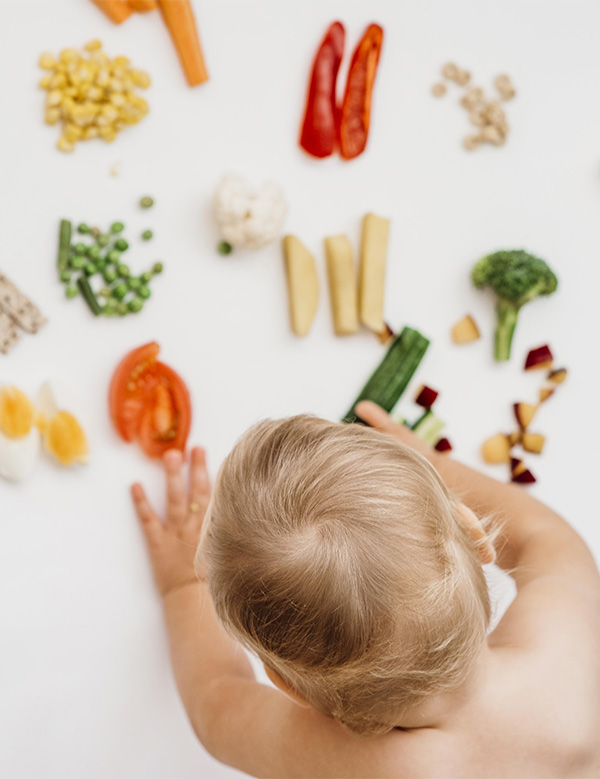Child Nutrition
What is Child Nutrition
The importance of Childhood Nutrition in the growth and development of a child cannot be overstated. The effects are so far-reaching that what a child eats is not only restricted to the child, but often, according to UNICEF, have multi-generational repercussions. According to a 2013 report, UNICEF documented 25% of all children under age five, a whopping 165 million of them, are affected by stunting (low height for age), which leads to irreversible damage to their physical and cognitive development. The devastation is not only restricted to undernutrition. (1) WHO found close to 340 million children and adolescents between ages 5-19 were either overweight or obese. In fact, the prevalence of obesity among children have risen four-and-a-half times (i.e. from 4% to more than 18%) in about 40 years. (2) In addition to the obvious socio-economic deprivations that lead to some of these terrible realities; the fact that even among middle and high income families across the world the repercussions of childhood malnutrition is rampant, cannot be denied.
Before delving deep into the problems related to nutrition that a child might face, and the kind of actions that we might take to address those problems, let’s briefly look at the physical and cognitive milestones a child generally meets growing up.
Need Consultation
Quickly Book an Appointment.

Developmental Milestones in Children
Before discussing the developmental milestones we must first put a caveat. As we do not expect all adults to be physically and cognitively similar, neither should we consider children as some kind of replicated copies of an ideal kid. Each of us are unique and different, and so are the children. Therefore the milestones should not be considered sacrosanct. Nevertheless, the childhood developmental milestones can serve as an important reference point to gauge a wide spectra of physical and cognitive development among children.
Neonatal (0-1 year)
Neonatal phase of a child is an incredibly fast phase of transformation. Babies grow and change a lot during this period. An infant’s journey begins with smiling on their own to smiling in response to others, to raising their head and chest when on their tummy, to tracking objects and later gripping them. They start producing babbling sound, laugh, and grab objects. In the later part of the first year they may start to crawl, sit without support and clap. Some infant might even begin taking their first steps during infancy.
Toddlers (1-3 years)
As the infant turn one they are often moving around more and becoming aware of themselves and their surroundings. They start showing greater independence and defiant behaviour. They also imitate other kids and adults around them. By the time the kids turn 2 they can jump with both their feet and throw a ball overhead. They also develop skills to avoid simple obstacles in their path. These years are extraordinary phase of rapid and dramatic postnatal brain development. Neural plasticity, working memory, attention and inhibitory control are also rapidly developed during these ages.
Pre-Schoolers (3-6 years)
By 3 most children can stand on one foot, hop and jump, can count up to 3, and answer simple questions. During these pre-school years they start to pedal tricycle, draw faces, stack cubes, identify shapes and colours, unscrew caps, sort and speak. They begin to open up and be even more independent. They recall part of stories, sing songs and distinct personalities begin to appear.
Lower and Upper Primary Schoolers (6-10 years)
By the time a child leaves primary school they have developed elaborately complex gross and fine motor skills that have been sharpened with practice, study and constant interactions with peer groups as well as with adults. Their thinking begins to become rational, and concrete stepwise operational thinking also enhances. During this entire phase of development, experiences changes a child and the brain develops multiple connections among nerve cells. (3)
The first decade of a human life is nothing short of a wonder. The metamorphosis from a single-celled zygote to a rational human being is truly an absolute miracle of Nature. This miracle is powered by the nutrition a child receives. Let’s look at the different nutritional components that facilitate these incredible growth and development story.
Balanced Childhood Nutrition
Right from enhancing growth, strengthening immune system, and developing cognitive functions, every aspect of a child is fostered by a nutritionally balanced diet.
Carbohydrate: Carbohydrate is the major source of energy for all cells and should provide for about 45%-65% of the total calories in the diet of a kid. Complex carbohydrate should be preferred, as excess sugar can displace important nutrients, thereby causing avoidable nutritional deficiencies. For simple carbohydrates, as well as for vitamins and fibres, fruits can play a very important part. Whole fruits, instead of fruit juice should be preferred. (4)
Protein: Protein requirement for infant and growing children are higher than those for adults, and a protein deficient diet may hamper development of brain, immune system and muscles. Essential amino acids comes through protein, and for vegetarian children sufficient quantities of legumes and corn should be taken to meet any ensuing deficiencies of amino acids. In addition to animal and plant sources, milk also forms an important protein source for children. Breast milk is the most important protein source for infants. (6)
Fat: The most important role for fatty acid is in the myelination of nervous system in children younger than two (Signutra). Fats also help in the absorption of fat soluble vitamins. Fats are important for overall neurological and ocular developments. For children younger than 2 years, 25% to 40% of total calories should come from fat, and for older children it should be around 10% to 35%. (4, 5 )
Micronutrients:
- Calcium– Calcium helps in the development of bone health. In addition to tofu, green leafy vegetables, ragi, and sesame seeds; milk and milk products are the most important sources of calcium. (5)
- Vitamin A- Vitamin A is important for vision and fighting infection. Yellow, orange and dark green fruits and vegetables are good sources of Vitamin A. (6)
- Vitamin D – Vitamin D helps in enhancing calcium and bone metabolism in children. Exposure to sunlight or taking vitamin D supplement is needed to meet up any Vitamin D deficiency among children. (5)
Iron- Iron deficiency is common among children which may lead to anaemia and other neurocognitive defects. Animal protein can be a good source of Iron. (6)
- Vitamin C- Vitamin C is found in lots of fruits that helps strengthen the immunity of a child. It should be taken along with Iron rich foods for better absorption of Iron in the body.
In addition to all these, there are some other vitamins and minerals, like Vitamin B complex, zinc, iodine and selenium that help in the growth and development of children. The combination of these micronutrients with the macronutrients described above, together create a balanced diet that has innumerable benefits to a child. In this context, I must briefly mention some extremely common problems that may result from deficiencies or imbalance in the diet a child might have.
Common Diet Related Problems Among Children
Obesity– As has been described how prevalent obesity is among children today, and while there might be several factors contributing to it; the extraordinary rise in the consumption of junk foods and free sugar containing food is probably among the very top. Physical inactivity is also one of the most important factors contributing to childhood obesity.
Constipation- Constipation is very common among infants, toddlers and pre-schoolers. One of the primary reasons contributing to constipation is the reluctance children often have in eating whole fruits and green vegetables. Sometimes the fact that children don’t like to drink much water may also contribute to exacerbate constipation.
Dental Cavity– Eating excessive sugary foods and reluctance in following basic oral hygiene often lead to problems like dental cavity.(7)
Immunity Related Problems- Cough, cold and seasonal flu are also very common among children, which are caused by a deficiency of natural foods in diet. This absence of natural foods may lead to omission of important vitamins and minerals, thereby contributing to reduction in immunity.
Apart from the problems described above, many other diet related problems may occur among children, and therefore consulting an expert in order to curate a balanced diet is often one of the most important things a parent can do to ensure the well-being of their child.

Food & Wellness Child Nutrition Programme
Food N Wellness understands the enormous importance of childhood nutrition in the growth and development of a child, both physically and cognitively. This has led the experts to design a perfectly balanced program addressing all the issues of childhood nutrition with care and precision. In the program, we conduct elaborate counselling sessions with parents so that together we may discuss the problems each child may be facing in their own unique ways, and address them separately and individually. In addition, we also provide guidance so that the issues of reluctance among children in drinking water and prevalence of eating too much of sugary foods might also be addressed. We work incessantly so that healthy habits among children might be fostered. The aim of Food N Wellness is to make sure that all the macro and micro nutrients in proper quality and quantity are present in the diet of a child, so that a kid can grow and prosper.
Let's get started with treating your condition...
At Food & Wellness we believe that every individual is different and needs special attention. We adapt our programme to your existing lifestyle and try not to change anything drastically so you can easily transition. Over a period of time we ensure results and help you restore your health.
Child Nutrition Articles

The Essential Role of a Child Dietitian and Nutritionist
Malnutrition in children is a serious global health problem that affects millions of lives every year. Malnutrition can be caused by a poor diet that does not provide enough calories, protein, vitamins, minerals and other essential nutrients for optimal growth and development. In fact, as per statistics, around 45% of deaths among children under 5

Dietary tips and remedies for constipation in kids
Constipation is a very common problem among kids. It is a condition characterized by an infrequent bowel movement, typically fewer than thrice a week. Constipation causes stool to become hard and dry, which causes children to face difficulties during their bowel movements.

Effects of too much sugar on children
Childhood and sugar are inextricably related. There are very few things a child like more than her sugary treats. Their world lights up with sugar in the form of chocolates, colourful candies, and other sweets. Sugar is so enormously loved by the children that parents often use them as rewards for good behaviour or for a job well done. The supply of sugar is also incessant. In addition to the parents, sugar in the form of chocolates and candies also come from visiting relatives and acquaintances, school friends, and from every other conceivable places. The result, needless to say, turns pretty debilitating. Excessive sugar in foods have long lasting health implications about which we shall discuss in the article.


